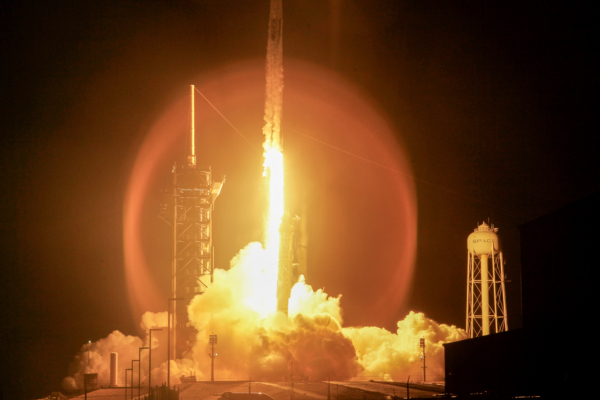SpaceX launched the “Polaris Dawn” mission from NASA’s Kennedy Space Center in the early hours of Tuesday (September 10). This mission not only involves crossing the dangerous Van Allen radiation belts, but also includes plans for the first commercial spacewalk by four private astronauts.
The astronauts boarded the Crew Dragon spacecraft and Falcon 9 rocket, which were launched at 5:23 am from Launch Pad 39A at NASA’s Kennedy Space Center in Cape Canaveral, Florida. The launch was originally scheduled for 3:38 am but was delayed due to weather conditions.
SpaceX’s CEO, billionaire Elon Musk, live-streamed the launch on his social media platform X.
Following the launch, the Falcon 9 rocket’s first-stage booster landed successfully on SpaceX’s unmanned ship in the sea after approximately nine and a half minutes. The Crew Dragon spacecraft then separated from the Falcon 9 second stage shortly thereafter.
The astronauts will spend five days in space before returning to Florida.
This launch, originally planned for the end of August, faced multiple delays. Issues with ground equipment at the launch site initially pushed the target date back by 24 hours, and subsequent launch attempts were postponed due to weather concerns.
During a routine satellite mission, the Falcon 9 rocket experienced a malfunction, leading federal regulators to temporarily halt all Falcon 9 rocket launches until SpaceX obtained approval on August 30 to resume rocket launches.
“‘Polaris Dawn’ mission is in flight!” SpaceX wrote on X.
This marks the fifth and most high-risk private mission for the Crew Dragon spacecraft to date. The spacecraft will ultimately enter an elliptical orbit, with the closest distance to Earth being 190 kilometers (118 miles) and the farthest reaching 1,400 kilometers (870 miles). This surpasses the height of the International Space Station (ISS) by more than threefold, as the astronauts will traverse the dangerous inner regions of the Earth’s Van Allen radiation belts. This mission leads humans to the farthest distance reached since the end of the 1972 Apollo moon landing program, paving the way for future explorations of the moon and Mars.
In the past, only highly trained government astronauts have conducted spacewalks. Since the establishment of the International Space Station in 2000, there have been approximately 270 spacewalks.
Since the retirement of the space shuttles in 2011, NASA has heavily relied on SpaceX and its Crew Dragon spacecraft. The Crew Dragon has completed nine crewed missions to and from the ISS for NASA.
The spacewalk in the “Polaris Dawn” mission is scheduled for the third day of the mission at an altitude of 700 kilometers and will last approximately 20 minutes. During this time, the Crew Dragon spacecraft will slowly depressurize. The spacecraft does not have an airlock like the ISS, so the four astronauts will rely on SpaceX-supplied thin space suits for oxygen.
The first American spacewalk took place in 1965 on a Gemini spacecraft, following a procedure similar to that of the “Polaris Dawn” mission: spacecraft depressurization, opening of the hatch, and astronauts in space suits venturing outside with safety tethers.
The funding for this mission comes from 41-year-old billionaire Jared Isaacman, the founder of the electronic payment company Shift4. Isaacman, who is the only person among the four crew members to have ventured into outer space, previously funded the 2021 Inspiration4 flight mission with SpaceX. He declined to disclose how much he spent on these missions, but the costs could reach hundreds of millions of dollars.
Accompanying him on this mission are pilot Scott Poteet, a 50-year-old retired U.S. Air Force colonel, as well as SpaceX senior engineer Sarah Gillis, 30, and Anna Menon, 38.
During the spacewalk, Isaacman and Gillis will exit the spacecraft, while Poteet and Menon will remain inside the cabin.
“Polaris Dawn” is the first of three crewed space flights under Isaacman’s private “Polaris” program. These missions aim to test SpaceX’s technology, including how to deal with cosmic radiation and the effects of space vacuum on human bodies, to facilitate future human ventures into deep space.
The project website indicates that the second mission “will continue to expand the boundaries of future human spaceflight missions, space-based communications, and scientific research.” Specific details, including the launch date, have not been disclosed.
On the day of the third and final “Polaris” mission launch, SpaceX’s Starship rocket will conduct its first crewed spaceflight. This massive rocket has only undergone unmanned tests so far and is scheduled to be used earliest in 2026 to transport NASA astronauts from lunar orbit to the lunar surface, as part of NASA’s Artemis program.
(Credit to articles from Fox, Reuters, and USA Today)

